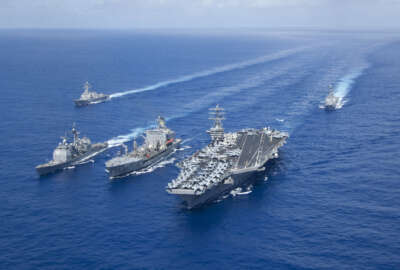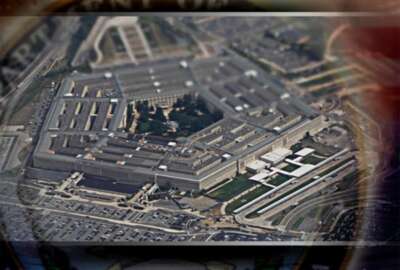Navy’s PEO-Digital turns to SBIRs for the first time
The Navy’s Program Executive Office Digital (PEO-Digital) turned to the Small Business Innovation Research program for the first time to find, test and hopefully...
The Navy’s Program Executive Office Digital (PEO-Digital) turned to the Small Business Innovation Research program for the first time to find, test and hopefully use innovative technologies to continually improve its processes.
PEO-Digital has phase one and two SBIRs to leverage technologies and make improvements with the goal of making work better for sailors and employees.
“That’s one place where we’re just getting more creative,” Justin Fanelli, the acting chief technology officer for the Department of the Navy and the technical director of PEO-Digital, told Federal News Network after an AFCEA NOVA panel. “We’re looking at more mechanisms. We have something that’s called Advanced Naval Technology Exercise so that we can do commercial solution offerings. We have both phase one and phase two [opportunities] going out.”
Fanelli said that PEO-Digital has streamlined the processes for small businesses by telling them what its objectives are and asking businesses how they would quantitatively show where the service branch is and how the business could help the Navy.
“That puts a little bit more ownership on them to deliver something, but it also puts a little bit more focus on how good are they at the job. Not how good are they at the interview,” Fanelli said.
Additionally, utilizing other transaction authorities (OTAs)and other acquisition authorities are important to modernize the service branch and help small firms overcome the valley of death that can happen with the SBIR program.
“The valley of death predates all of us from a technology adoption, innovation adoption perspective,” Fanelli said. “It’s something that we’ve really had our eyes on because we think that it can help mission outcomes more than ever.”
Fanelli said the Defense Innovation Unit also is a valuable partner because of the help to award OTAs, catalog items and scout for different technologies. He said that working with DIU and other research and development partners, ecosystem partners from the Office of Naval Research, venture-backed companies as well as traditional and non-traditional partners will help make improvements.
“IT for IT sake is not only not interesting, but it underserves our warfighters and that there is an opportunity to improve their lives and put more time on what they signed up for in terms of duty,” Fanelli said. “In general, the connectivity is the air we breathe. If we can make that seamless and frictionless and dependable, we want to do that.”
He said there are five mission outcomes PEO-Digital looks at when working with partners like DIU and pursuing SBIR contracts to help prioritize projects, namely:
- User time lost
- Operational resilience
- Net promoter score
- Cost per user
- Adaptability
PEO-Digital has projects in these focus areas and will continue work in these areas over the next year.
Fanelli said there have been some recent wins too. Some of them are in beta or early phases. Specifically, these wins include ways to let users get directly into the cloud or perform their job with approximately 10% of the hops compared to before. He said they have also utilized multifactor authentication to enable users who do not have a common access card or work in a secure office to save steps in their day. He said they have also made improvements on the back end for systems to work better. Fanelli said with Naval Identity Services, they are inheriting zero trust capabilities, so they do not have to create their own.
“The more enterprise services we have, the more it’s going to be downhill running in the best way so we can focus on what’s important to this group,” Fanelli said.
Operation Cattle Drive, which aims to reduce the Navy’s duplicative systems, is critical to help modernize and streamline operations while also saving it money.
“We want to really up the ante on that Cattle Drive piece and I believe enterprise services is kind of the yinyang with Cattle Drive,” Fanelli said. “If we get after both of those, then we have potentially a clear path to serving our warfighter better.”
At a Navy IT day sponsored by AFCEA NOVA last Friday, Fanelli and other panelists — including Kevin Allen, the enterprise systems department head for the Naval Information Warfare Center Atlantic and Atlas Eftekhari, the deputy program executive officer for contracts administration at the Department of the Navy — said working with small businesses is important to help propel mission outcomes. They agreed on the need for businesses to really explain how they can help the Department of the Navy with their technology and domain experience, while understanding government objectives.
The panelists added that businesses should do their homework and demonstrate how they can help. Furthermore, businesses should be engaged with the government and look for mentorship with businesses that have been in this space for a while that work with the government.
Copyright © 2025 Federal News Network. All rights reserved. This website is not intended for users located within the European Economic Area.
Kirsten Errick covers the Defense Department for Federal News Network. She previously reported on federal technology for Nextgov on topics ranging from space to the federal tech workforce. She has a Master’s in Journalism from Georgetown University and a B.A. in Communication from Villanova University.
Follow @kerrickWFED






